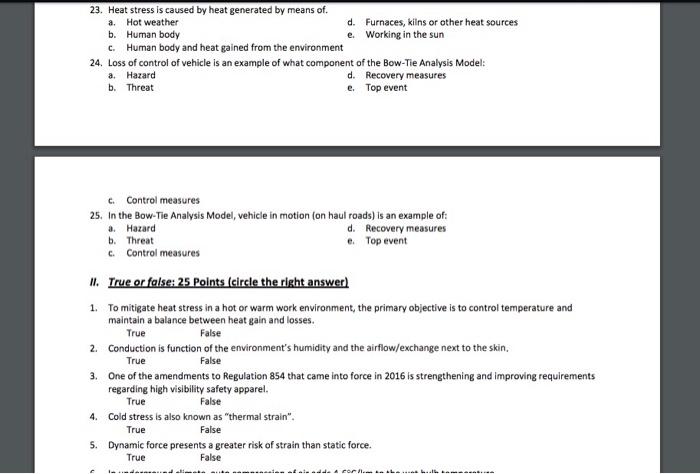a. 23. Heat stress is caused by heat generated by means of. Hot weather d. Furnaces, kilns or other heat sources b. Human body e. Working in the sun c. Human body and heat gained from the environment 24. Loss of control of vehicle is an example of what component of the Bow-Tie Analysis Model: a. Hazard d. Recovery measures b. Threat e. Top event c. Control measures 25. In the Bow Tie Analysis Model, vehicle in motion (on haul roads) is an example of: a. Hazard d. Recovery measures b. Threat e Top event c Control measures II. True or folse: 25 points (circle the right answer) 1. To mitigate heat stress in a hot or warm work environment, the primary objective is to control temperature and maintain a balance between heat gain and losses. True False 2. Conduction is function of the environment's humidity and the airflow/exchange next to the skin. True False 3. One of the amendments to Regulation 854 that came into force in 2016 is strengthening and improving requirements regarding high visibility safety apparel. True 4. Cold stress is also known as "thermal strain". True False 5. Dynamic force presents a greater risk of strain than static force. True False False I. tasadda coria....... 17. Raynaud's phenomenon is an established hand disorder amongst miners exposed to vibration. True False 18. Risk management is the determination of quantitative or qualitative value of risk related to a concrete situation and a recognized threat (also called hazard). True False 19. Unwanted event/incident is an element which alone or in combination has the intrinsic (natural) potential to give rise to risk. True False 20. One of the reasons risk assessment is used is regulatory and under the regulation, the Internal Responsibility System imposes a duty on everyone to take action. True False 21. Proactive decision making occurs after the event with the objective of preventing it happening again. True False 22. A tactical decision making in risk assessment is an informal, timely, and rules-based method. False 23. Slips/lapses are intentional type of human errors. True False 24. Violation is the second most type of human error based on statistics of 25 serious incidents. True False 25. Damaged business reputation is an example of consequences. False True True III. Short Answer Questions: 10 Points What are these acronyms stand for








